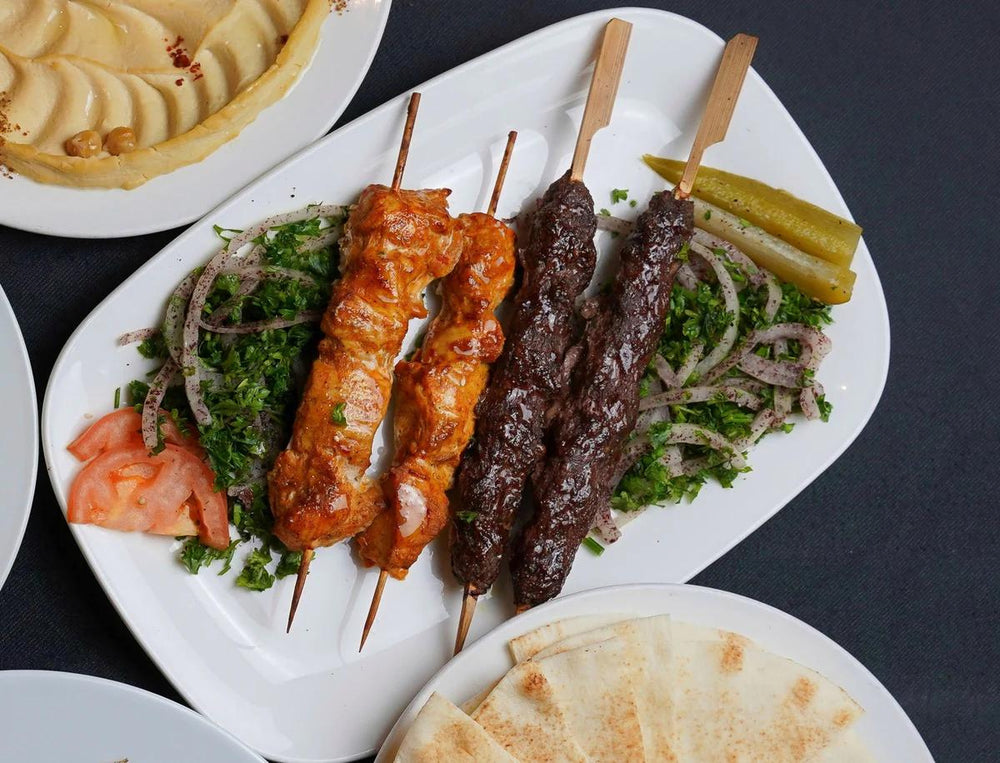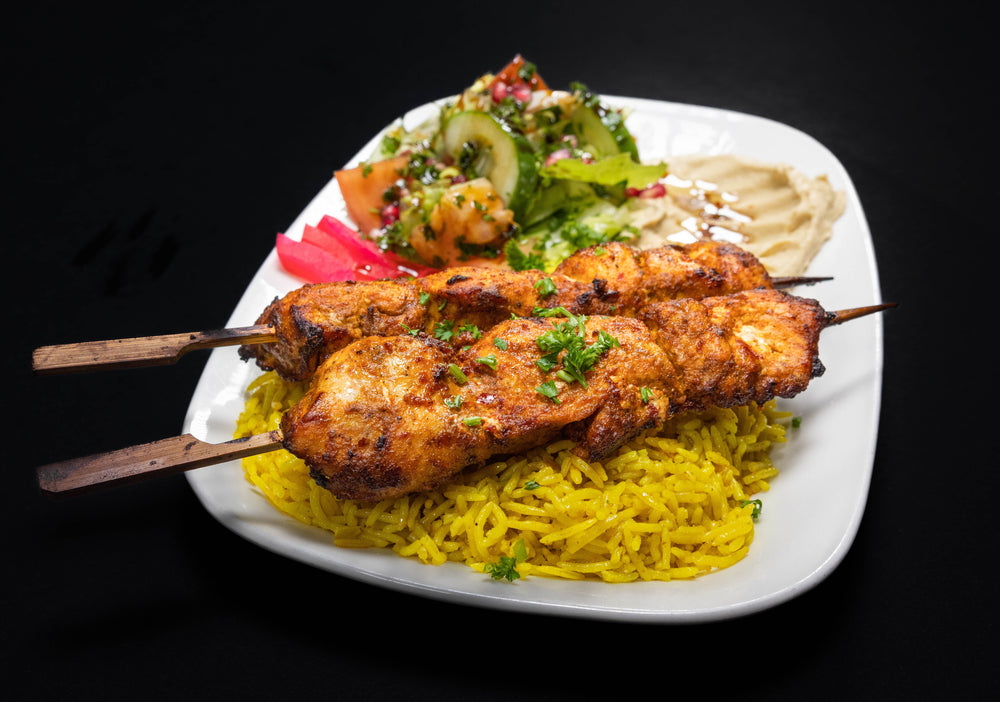All Regarding the Rich Flavors and Traditions of Syrian Cuisine: A Culinary Journey
Syrian cuisine provides a special blend of flavors and practices that reflect its rich cultural history. With staple ingredients like olive oil and garlic, together with a range of seasonings, the recipes are both varied and inviting. From the detailed prep work of kibbeh to the sweet appeal of baklava, each element of this culinary landscape exposes much deeper stories. As one explores the significance of these tastes, a better understanding of common dining and celebration arises.
The Essence of Syrian Components
The essence of Syrian active ingredients depends on their rich diversity and deep-rooted cultural significance. Influenced by the country's different location and background, Syrian cuisine integrates a vast selection of flavors, herbs, and fresh fruit and vegetables. Staples such as olive oil, garlic, and lemon supply a foundation, while flavors like sumac, cumin, and coriander add deepness and complexity to dishes.The use fresh natural herbs, including parsley and mint, highlights the value of seasonal ingredients. Furthermore, the area's fertile dirt returns a wealth of veggies and fruits, such as eggplants, pomegranates, and tomatoes, which are indispensable to numerous recipes. Grains like bulgur and rice form the base of numerous dishes, underscoring the relevance of these active ingredients in Syrian culture. This blend of flavors mirrors not simply a culinary custom but additionally a tapestry of historical influences, making Syrian active ingredients necessary to recognizing its food's lively character.

Iconic Cuisines of Syrian Cuisine
Syrian food is renowned for its legendary recipes that showcase an abundant tapestry of structures and tastes. Typical meze plates provide a selection of small meals that tantalize the taste buds, while hearty main dishes provide satisfying focal points for meals (Afternoon Tea Vancouver). To finish the experience, an option of scrumptious desserts includes a wonderful note to the culinary journey
Traditional Meze Plates

Hearty Main Courses
Passionate main dishes act as the focal point of Syrian eating, showcasing a blend of flavors that mirror the country's abundant culinary traditions. Recipes such as kebab hindi, including marinaded lamb skewers, and the well known mujaddara, a reassuring combination of lentils and rice, highlight the use of fresh active ingredients and fragrant spices. An additional staple is the renowned kibbeh, made from bulgur wheat and minced meat, typically served in various kinds, consisting of baked, fried, or raw. Additionally, the tastes of the land come alive in meals like stuffed veggies, called mahshi, which are filled up with rice, meat, and natural herbs. These main dishes not only please appetite yet likewise inform stories of household gatherings and cultural heritage.
Savory Treats Choice
A fascinating variety of treats specifies the wonderful side of Syrian cuisine, offering an alluring end to any kind of meal. Among the most renowned confections are baklava, fragile layers of phyllo bread filled with nuts and saturated in syrup, and maamoul, shortbread-like cookies typically packed with days or nuts. Knafeh, an abundant dessert made from slim noodle-like pastry soaked in syrup and split with cheese, is a prominent choice, particularly throughout cheery celebrations. In addition, the aromatic and sweet rice dessert, known as roz bil laban, gives a comforting finish. These scrumptious treats not just showcase the region's cooking competence however additionally show the cultural heritage of Syria, making them valued treats in both restaurants and homes alike.
Typical Cooking Methods
Although modern benefits have actually influenced numerous cooking techniques, standard food preparation techniques remain crucial to Syrian food. These techniques typically highlight the usage of fresh, seasonal components and concentrate on sluggish food preparation to develop abundant tastes. Strategies such as barbecuing, braising, and cooking prevail, enabling the all-natural tastes of the active ingredients to shine through.One remarkable technique is the preparation of kibbeh, a meal made from carefully ground meat and bulgur. It calls for proficient hand-rolling right into different shapes and can be baked, fried, or offered raw. In addition, the art of making bread, specifically pita, is main to lots of dishes, often cooked visit this web-site in a typical stone oven.Preservation techniques like pickling and fermenting likewise play a vital role, enhancing the diversity of flavors found in Syrian dishes. These techniques not only show the region's farming heritage but additionally cultivate a strong feeling of neighborhood via shared culinary techniques.

The Role of Spices in Flavor
Flavors offer as the heart beat of Syrian cuisine, instilling recipes with complicated flavors and aromatic depth. Each flavor plays a crucial function, adding not only to preference but likewise to the social heritage of the area. Commonly used spices include cumin, sumac, and coriander, each offering an unique account that elevates conventional dishes. As an example, cumin offers heat and earthiness, while sumac adds a tasty brightness, boosting the general dish.Syrian chefs frequently mix seasonings to produce harmonious accounts, mirroring the intricate equilibrium of flavors that specify the food. Using seasonings is not just for spices; it also serves to protect food and improve its dietary worth. This thoughtful incorporation highlights a deep understanding of the cookeries, where spices end up being essential authors, sharing the rich history and varied influences that identify Syrian gastronomy. Ultimately, seasonings are important in crafting memorable and genuine Syrian dishes.
Festive personalizeds and celebratory meals
Commemorative dishes in Syrian food are marked by conventional feast meals that mirror the nation's abundant culinary heritage. Special celebrations commonly involve distinct rituals that boost the common experience of eating. These customs not only recognize the value of the events but also enhance social and familial bonds.
Standard Banquet Dishes
When families collect to celebrate substantial celebrations in Syria, conventional feast dishes take facility phase, showcasing the abundant culinary heritage of the region. These gatherings frequently include lively platters of mezze, consisting of hummus, baba ghanoush, and tabbouleh, which act as fascinating starters. The primary course commonly highlights lamb or hen, marinated and cooked to perfection, commonly come with by great smelling rice pilaf or bulgur. Among the most beloved dishes is maqlooba, a layered rice dish with vegetables and meat, turned inverted prior to serving. Desserts additionally play a vital duty, with baklava and knafeh using a pleasant finish to the dish. Each recipe not only delights the palate but likewise shows the deep-rooted practices and common spirit of Syrian society.
Unique Event Rituals
Unique occasions in Syria are marked by abundant routines that intertwine food and festivity, reflecting the social significance of common events. Congratulatory meals often consist of typical meals such as kibbeh, tabbouleh, and numerous barbequed meats, prepared with care and shared amongst family members and friends. During religious vacations like Eid al-Fitr and Eid al-Adha, households integrated to prepare unique sweets like maamoul, representing unity and joy. Weddings are especially elaborate, including several courses and vivid screens of friendliness. These occasions are not merely regarding food; they encompass storytelling, songs, and dance, reinforcing social bonds and social heritage. Through these routines, Syrians commemorate life's turning points, making certain traditions are passed down through generations, enriching their culinary landscape.
The Significance of Sharing and Community
Sharing meals is a fundamental aspect of Syrian culture, mirroring the deep-rooted values of neighborhood and link. In Syria, food is not simply nutrition but a way of bringing individuals with each other. Family members and friends gather around the table to take pleasure in typical meals, fostering bonds and producing enduring memories. This common dining experience stresses hospitality, where hosts most likely to great sizes to guarantee every visitor feels invited and nourished.The act of sharing food additionally represents generosity and solidarity, reinforcing social connections within communities and bigger neighborhoods. During celebrations, it prevails for individuals to serve each various other, showcasing a spirit go to these guys of togetherness that transcends individualism. Celebrations, whether big or tiny, are typically noted by the sharing of meals, where varied tastes and dishes integrated, mirroring the rich tapestry of Syrian society. As necessary, the value of sharing and neighborhood in Syrian cuisine is not just a cooking custom however a critical social practice.
A Cooking Expedition of Syrian Sweets
Usually outweighed by full-flavored dishes, Syrian desserts hold a cherished area in the country's cooking heritage (Afternoon Tea Vancouver). These confections mirror the area's abundant history, mixing tastes and techniques from various societies. Typical web desserts like baklava, with its layers of phyllo bread, nuts, and honey syrup, showcase the virtuosity involved in Syrian cooking. Ma'amoul, a shortbread-like cookie full of days or nuts, is typically planned for festive occasions, representing friendliness and celebration.Another beloved sweet is Knafeh, a pastry taken in syrup and layered with cheese or lotion, offering a delightful comparison of structures. Syrians likewise enjoy a range of fruit syrups and preserves, usually served with tea or as component of a bigger spread throughout celebrations. These sweets not only satisfy the taste however also work as a bridge between generations, maintaining the customs and stories of Syrian society through each scrumptious bite
Often Asked Questions
What Are the Wellness Perks of Conventional Syrian Foods?
The wellness advantages of standard Syrian foods include abundant nutrients from fresh veggies, legumes, and entire grains. These components promote heart health and wellness, improve food digestion, and give necessary vitamins, adding to overall wellness and a balanced diet regimen.
Exactly How Has Syrian Food Developed For Many Years?
Syrian cuisine has actually progressed significantly, influenced by historical profession routes, social exchanges, and regional availability of ingredients. Traditional meals have actually incorporated contemporary flavors and techniques while maintaining their abundant heritage, showing a diverse cooking landscape.
Are There Vegetarian or Vegan Options in Syrian Food?
Syrian food uses various vegan and vegan choices, including recipes like falafel, tabbouleh, and packed grape fallen leaves. These meals highlight the region's abundant agricultural heritage, showcasing fresh vegetables, grains, and aromatic seasonings in dynamic combinations.
What Beverages Set Well With Syrian Dishes?
When thinking about drinks that complement Syrian dishes, one might locate that mint tea, ayran, and pomegranate juice boost the dish's tastes. In addition, red a glass of wine frequently sets well with the seasonings frequently discovered in these foods.
How Can I Recreate Syrian Meals in your home?
To recreate Syrian meals at home, one ought to discover genuine recipes, gather traditional ingredients, and utilize cooking techniques unique to the cuisine. Trying out seasonings and discussion likewise improves the general dining experience. Syrian food is renowned for its legendary dishes that showcase an abundant tapestry of appearances and tastes. Flavors offer as the heartbeat of Syrian food, instilling dishes with complicated tastes and fragrant depth. Congratulatory dishes in Syrian food are marked by traditional feast meals that mirror the nation's abundant culinary heritage. Celebrations, whether small or big, are usually marked by the sharing of meals, where diverse flavors and dishes come together, showing the rich tapestry of Syrian society. Syrian food supplies countless vegan and vegan alternatives, including recipes like falafel, tabbouleh, and stuffed grape fallen leaves.